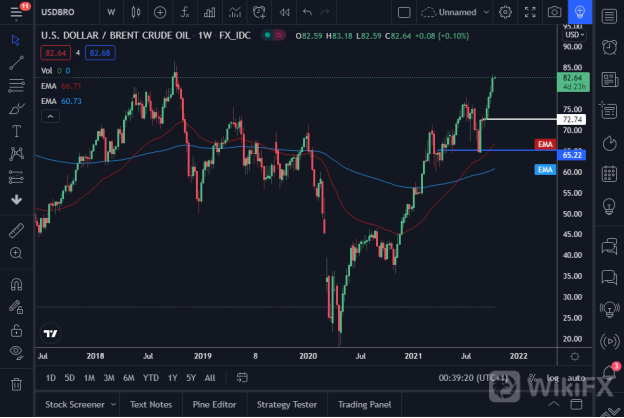
The price of commodities keeps soaring as the world economy reopens after the pandemic. Brent Crude oil, one of the most essential commodities in the world, has seen a massive increase in its price after the pandemic. The price of oil has soared by over %250 since it hit its lowest price of $16 in almost two decades, according to data received from TradingView.

Goldman Sachs, a Global Investment Banking Company, predicted the price of oil to rise to $80 before the end of the third quarter. The prediction was made in May 2021, when the price of oil was averaging $65 per barrel. And just as predicted by the Investment Banking Company, Brent Crude Oil hit the $80 mark on the 28th of September before closing at $78.16. Price has gone beyond the $80 mark, as the fourth quarter begins, rising to $83 per barrel.
The increase in the price of oil is a result of the increase in the demand for oil around the world, as the economy reopens after the pandemic. However, the struggles of the Organization of the Petroleum Exporting Countries, OPEC, to pump more oil to meet rising demand caused the major surge in the price of oil.
The Organization of the Petroleum Exporting Countries and allies or OPEC+ as the alliance is known, have fallen short in the production of oil to meet global demand as it recovers from the coronavirus pandemic.
“Several OPEC+ members such as Nigeria, Angola, and Kazakhstan have struggled in recent months to raise output due to years of under-investment or large maintenance work that has been delayed by the COVID-19 pandemic.” Reuters
“Cheating and producing above targets have traditionally been one of OPEC's main problems but the situation has changed in recent years as investment has flowed into the renewables sector as part of the energy transition.” Reuters
“Despite the rise in renewables, the world is still consuming near-record amounts of crude, which will put additional pressure on Saudi Arabia and OPEC's other leading Gulf producers to pump more oil in the years to come.” Reuters
In May, OPEC planned to increase oil production by 500,000 barrels per day for the rest of the year, but the inability of some members to raise output to agreed levels suggests a supply gap could develop as the group proceeds with a plan for monthly output increases to unwind the rest of record supply cuts made in 2020. And this could increase the burden on top producers like Saudi Arabia if demand starts to recover and exceed pre-pandemic levels, which forecasters say could happen as soon as the second quarter of next year.
“Earlier this month, OPEC+ agreed to increase output targets by a further 400,000 barrels per day in October. But production data for August shows that the main under-producers were African OPEC members Nigeria and Angola and non-OPEC member Kazakhstan.” Reuters
“Underinvestment, a lack of exploration and the exit of some oil majors have stymied efforts by Angola and Nigeria to raise output, an issue that is expected to continue impacting the West African producers in the near future.” Reuters
In addition, global oil supplies have also taken a hit from hurricanes Ida and Nicholas passing through the Gulf of Mexico and damaging US oil infrastructure.
In a sign of strengthening fuel demand, East Coast refinery utilization rates in the United States rose to 93%, the highest since May 2019, EIA data showed. Surging natural gas prices also are supporting market sentiment, ANZ Research said.
A dramatic surge in natural gas prices has also made oil a relatively cheaper alternative for power generation, which in turn has increased demand.
“Supply shortage of gas could encourage power utilities to shift from gas to oil if winter turns out to be colder this year,” ANZ analysts wrote in a note.
The Vitol Group, the world's biggest independent oil trader, said it expected global demand for crude to increase by 500,000 barrels per day this winter.
“Similarly, India, the second-biggest importer of crude oil, has also ramped up its oil imports to a three-month high in August, as refiners begin to stock up as they project higher demand going forward”, as reported by BBC.
The widening energy crunch around the world, most especially in Europe and the UK has prompted Goldman Sachs to project a global energy rally for months to come.
“The investment Bank forecast that Brent Crude Oil would hit $90 a barrel before the end of the year, and warned that rising input costs, higher gas prices, and weaker growth were likely to weigh on European corporate profit growth for 2021.” Financial Times
“When growth slows, it becomes harder for companies to pass on higher input cost, which is the main risk for net income margin.” Goldman Sachs
The price of Brent crude oil is trading at $83.18 at publishing time and will likely rise to $86, which is 2018's high. If the current buyers' momentum breaks above 2018's high, oil price could rise to $100 per barrel by the first quarter of next year.
Leave a Reply